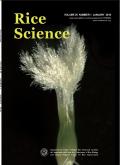调控再生速率提高再生稻产量
IF 5.6
2区 农林科学
Q1 AGRONOMY
引用次数: 0
摘要
轮作水稻(Oryza sativa L.)是一种可持续的种植模式,其种植面积逐年增加。然而,关于调节再生率的措施和机制以及轮作水稻生产所面临的挑战的文献还很缺乏。本研究探讨了不同品种、气候条件(光照和温度)和栽培措施(肥料管理、耕作制度、收获方法、水分管理和植物生长调节剂)对再生率和稻谷产量的影响。该研究从物质积累和运输、激素代谢和分子机制等方面总结和分析了影响再生芽萌发的可能机制,并确定了目前限制晚稻发展的主要因素。在品种、温度、光照资源和栽培措施的调节下,研究发现再生率与一季稻的产量呈明显的正相关。提高再生率可有效提高晚稻产量。值得注意的是,再生能力强的水稻品种具有生长期适宜、根系发达、单株重高、粒数与绿叶面积比相对较小、主季抗倒伏能力强等特点。此外,再生芽的萌发受内源激素(吲哚-3-乙酸、赤霉素和细胞分裂素)、光同化物(非结构性碳水化合物)和活性氧代谢的积累和运输的调节。为进一步展示轮作季节的粮食增产潜力,需要在三个关键领域进行改进:低茬口轮作水稻的栽培系统、专用收割机的开发,以及培育主茬期间耐高温、轮作期间耐低温的水稻品种。本文章由计算机程序翻译,如有差异,请以英文原文为准。
Regulation of Regeneration Rate to Enhance Ratoon Rice Production
Ratoon rice (Oryza sativa L.) is a sustainable planting model, and its planting area has been increasing year by year. However, there is a lack of literature reviewing the measures and mechanisms to regulate the regeneration rate, as well as the challenges in the production of ratoon rice. This study explores the effects of different varieties, climatic conditions (light and temperature), and cultivation measures (fertilizer management, cropping system, harvest method, water management, and plant growth regulators) on the regeneration rate and grain yield of the ratoon season. It summarizes and analyzes the possible mechanisms that affect the germination of regenerated buds from the perspectives of material accumulation and transportation, hormone metabolism, and molecular mechanisms, and identifies main factors currently limiting the development of ratoon rice. A significant positive correlation between the regeneration rate and grain yield of the ratoon season was found, regulated by varieties, temperatures, light resources, and cultivation measures. Improving the regeneration rate can effectively increase the production of ratoon rice. Notably, rice varieties with high regeneration ability exhibit characteristics such as a suitable growth period, a developed root system, high single-stem weight, a relatively small ratio of grain number to green leaf area, and strong lodging resistance in the main season. Additionally, the germination of regenerated buds is regulated by the accumulation and transport of endogenous hormones (indole-3-acetic acid, gibberellins, and cytokinins), photoassimilates (non-structural carbohydrates), and reactive oxygen metabolism. To further demonstrate the grain yield potential of the ratoon season, improvements are needed in three key areas: the cultivation system of low-stubble ratoon rice, the development of specialized harvesters, and the breeding of rice varieties with high-temperature tolerance during the main crop and low-temperature tolerance during the ratoon crop.
求助全文
通过发布文献求助,成功后即可免费获取论文全文。
去求助
来源期刊

Rice Science
Agricultural and Biological Sciences-Agronomy and Crop Science
CiteScore
8.90
自引率
6.20%
发文量
55
审稿时长
40 weeks
期刊介绍:
Rice Science is an international research journal sponsored by China National Rice Research Institute. It publishes original research papers, review articles, as well as short communications on all aspects of rice sciences in English language. Some of the topics that may be included in each issue are: breeding and genetics, biotechnology, germplasm resources, crop management, pest management, physiology, soil and fertilizer management, ecology, cereal chemistry and post-harvest processing.
 求助内容:
求助内容: 应助结果提醒方式:
应助结果提醒方式:


